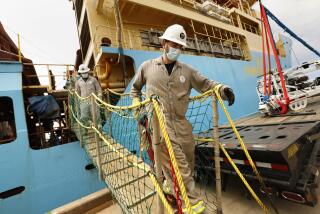An Ocean of Profit Potential : Partners Purifying, Carbonating Seawater, Marketing It as Flavored, Bottled Beverages
- Share via
NEWPORT BEACH — Turning salty ocean water into drinkable, even tasty commercial beverages may transform two Newport Beach entrepreneurs into successful business owners.
The founders of fledgling Seaborn Beverages Co. say their company will be the nation’s first to make clear, carbonated and flavored water from seawater. The water is gathered near Santa Catalina Island, purified in Long Beach, then packaged in dark blue glass bottles under the “Seaborn” name.
“The oceans are the best known natural bodies of water and represent one of the last and most pure waters on Earth,” said Bruce Sweyd the 47-year-old company co-founder with partner Frederik Rodenhuis, 39. “The idea to use this water was really the result of a joint brainstorming effort. We wanted to come up with a breakthrough product.”
Because the specialty bottled-water market is so competitive, the company hopes to hook consumers on its product’s uniqueness--a beverage derived from purified seawater. They also hope buyers will be attracted by the ecological implications of a product that doesn’t reduce the world’s dwindling supply of fresh water.
Initially to be marketed along the West Coast, Seaborn products should be available this January in three flavored versions, with names like “Catalina Cherry” and “Island Tangerine,” and one unsweetened, unflavored version called “Natural Sparkling.”
An estimated 300,000 bottles are being readied for store shelves at the J&R; Bottling and Distribution Co. in Montebello, near downtown Los Angeles. And with the 11-ounce beverages priced about $1 each, the company projects first-year sales of between $3 million and $6 million.
The two company founders met while working at the Southern California office of Original New York Seltzer in Walnut. Both shared an entrepreneurial streak and desire to branch out on their own with a unique project, so they left the company in summer of 1992.
“Well, no guts no glory, right?” said Rodenhuis, a native of Holland. “It’s not easy, we’ve spent a lot of sleepless nights. But we think we have a terrific concept.”
The public company raised $500,000 in start-up capital by selling securities through small corporate-offering registration programs in six states, including California. The company also received at least $300,000 in investment capital from several distributors in California, which the men declined to identify.
“We’ve been working with these guys for the past year,” said Gary Huggard, a director of Mesa Distributing Co., a San Diego company that will distribute Seaborn sodas.
“It’s an intriguing concept, especially here on the West Coast with all the talk of water shortages,” he said. “And they have the ability to produce a great-tasting product.”
Brenda Berry, a partner with Arthur Andersen in Newport Beach, the company’s accountant, said she is impressed by the concept and especially the management at Seaborn.
“I think it’s very exciting,” Berry said. “We checked into management’s backgrounds, and we felt they had the ability to see the product through and become successful.”
Officials at Calistoga Mineral Water Co. in Northern California said they are not too concerned about the added competition.
“If they bring a product with integrity to the marketplace, then they are welcome,” said Bob Pussey, Calistoga’s special events manager.
Prompted by drought conditions, several California communities have considered removing the salt from seawater. Widely used in the Middle East and the Caribbean, desalination has not been as popular in the United State because of its higher cost of providing potable water.
Most desalination plants use either the distillation or reverse-osmosis process; Seaborn uses the latter. In reverse osmosis, seawater is passed through a thin plastic membrane with very small pores. These pores allow water molecules through, but not the salts, viruses or bacteria.
Seaborn takes water from the western side of Catalina and ships it to Long Beach on water-supply vessels operated by Foss Maritime in that city.
“There is a perception that the water near Catalina is cleaner than off Newport,” said Sweyd. “And indeed, it was some of the cleanest water we could find.” Foss employees operate the desalination equipment in Long Beach, which is leased for $5,000 a month by Seaborn from Aqua Design of Campbell, in Northern California, which has designed several desalination plants. The Long Beach plant, a tiny facility, can only purify 3,000 gallons a day.
William R. Mills, general manager of the Orange County Water District, which operates a Fountain Valley plant that uses reverse osmosis to clean 5 million gallons of water each day, expressed skepticism about Seaborn’s idea.
“I don’t know why anyone would do that. The costs are much higher to use seawater when they could use ground water or brackish water, which is a much less salty than seawater,” said Mills. “It seems to be unnecessarily making your costs high.”
But Seaborn thinks potential profits will far outweigh its desalination costs. While planning on making big bucks with Seaborn, it also hopes to send an environmental message about the ocean.
“We hope that people will think twice about polluting the ocean, because they will think, ‘My God, why do I want to pollute the water I drink?’ ” said Sweyd. “This is not going to change the world, but maybe it will send a message to let people know not to pollute the seas.”
More to Read
Inside the business of entertainment
The Wide Shot brings you news, analysis and insights on everything from streaming wars to production — and what it all means for the future.
You may occasionally receive promotional content from the Los Angeles Times.










